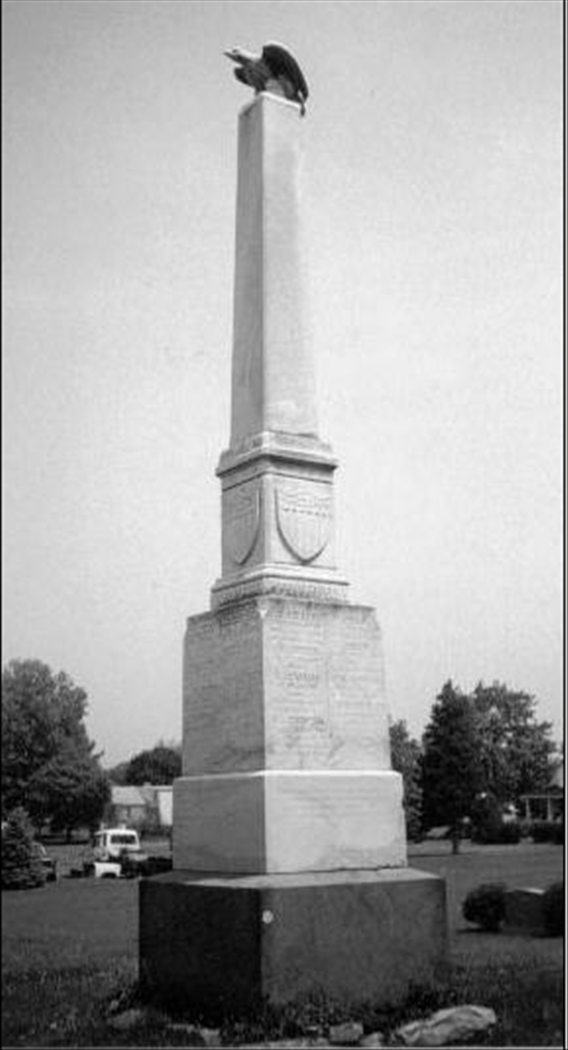

Study Areas:
Lower Paxton
Township, Dauphin County
Willow Grove Cemetery, Civil War Monument
 Tucked
away in a small Lower Paxton Township cemetery is one of the most overlooked
Civil War monuments in Dauphin County. The Willow Grove Cemetery is
located about one-half mile south of the square in Linglestown, on
the east side of Mountain Road. Near the center of this well maintained
cemetery is a 25-foot column, topped by an eagle, and on each of the
four sides of the column are the names of the former residents of this
part of the county who gave their lives for the Union. A total of 39
names are etched on the memorial, along with their company and regiment,
the date they died, and the battle or campaign in which they died.
(click here for the list of names inscribed on the monument.)
Tucked
away in a small Lower Paxton Township cemetery is one of the most overlooked
Civil War monuments in Dauphin County. The Willow Grove Cemetery is
located about one-half mile south of the square in Linglestown, on
the east side of Mountain Road. Near the center of this well maintained
cemetery is a 25-foot column, topped by an eagle, and on each of the
four sides of the column are the names of the former residents of this
part of the county who gave their lives for the Union. A total of 39
names are etched on the memorial, along with their company and regiment,
the date they died, and the battle or campaign in which they died.
(click here for the list of names inscribed on the monument.)
The monument was erected in 1868, according to an inscription near the base, “by the loyal citizens through the energy of W.C. Smith, M.D.,” making it one of the earliest monuments in the county honoring the dead of this war. Smith, a longtime resident of the county and influential local figure, is buried in a family plot not far from the war memorial, under a monument that is the second largest in the cemetery, second only to the Civil war monument itself. His tomb is marked with the inscription “a practitioner of medicine in this community.”
Each
of the four sides of the Civil War obelisk is dedicated to one of the
four townships that comprise this part of the county. Under the township
name are the names of the war dead from that township. A few lines
from “The Bivouac of the Dead” by Theodore O’Hara
(1820-1867) adorn the side next to the cemetery lane—
On Fames eternal camping ground,
Their silent tents are spread;
And Glory guards with solemn round,
The Bivouac of the dead.
Although O’Hara wrote the poem to honor those killed in the Battle of Buena Vista in 1847, in which he fought, it has been more frequently associated with the dead of the Civil War, and is in use in both Arlington National Cemetery and Gettysburg National Cemetery. Interestingly, O’Hara was a southerner who fought for the Confederacy during the war.
In addition to the Civil War Memorial, the Willow Grove Cemetery has many examples of popular tombstone art from the mid-19th century, including tall obelisks on adult tombs and miniature obelisks for children, bas-relief carvings, sculptured lambs and lilies, representations of “wooden” log crosses, and doves, among others. It also features a tomb for the Spancake/Fackler family, surmounted with an impressive Gothic arch portico. Some fine examples of modern non-traditional tombstone art can be found with the modern burials, particularly some striking heart-shaped tombs. Mature trees provide shade and beauty to the small cemetery, which can be easily toured in less than a half-hour.
Directions to Willow Grove Cemetery: From Interstate 81-S, take Exit 26 (Linglestown) and proceed north on Mountain Road, about one and one-half miles to the cemetery entrance, which will be on the right. From Front Street in Harrisburg, drive east on Route 39 to the square in Linglestown (Mountain Road). Turn right at the square and proceed south on Mountain Road for about one-half mile to the cemetery entrance, which will be on the left.
Article
by George F. Nagle
This article originally appeared in The Bugle, the newsletter
of the Camp Curtin Historical Society 10/2 (April-June 2000).
